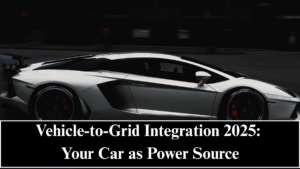In 2025, Vehicle-to-Grid (V2G) technology has evolved from a futuristic concept into a mainstream solution for balancing energy demand. Electric vehicles are no longer just modes of transport—they’re now mobile power stations capable of storing and delivering electricity to homes and power grids when needed.
As EV adoption rises worldwide, the combined battery capacity of millions of vehicles has created a new, flexible energy network. With V2G integration, this massive energy storage resource is helping stabilize grids, support renewable power, and even lower electricity bills for consumers.

Understanding Vehicle-to-Grid (V2G) Technology
V2G technology enables bidirectional energy flow between electric vehicles and the power grid. Unlike traditional charging, which only draws electricity from the grid, V2G-equipped EVs can send stored energy back to it.
Key components of the system include:
-
Smart chargers capable of two-way power exchange.
-
Cloud-based management systems that monitor energy demand and battery levels.
-
Dynamic pricing algorithms that determine when to charge or discharge for maximum efficiency.
This creates a mutually beneficial relationship between EV owners and utility providers—cars get charged during low-demand hours, and energy is supplied back during peak demand periods.
How V2G Is Changing the Energy Landscape
Vehicle-to-Grid integration plays a pivotal role in modernizing the smart energy ecosystem. Its benefits go far beyond convenience:
-
Grid Stability: EVs act as decentralized energy storage, reducing blackouts and grid stress.
-
Renewable Energy Integration: V2G balances solar and wind fluctuations by storing excess energy and redistributing it later.
-
Lower Energy Costs: Homeowners and businesses can sell stored power back to the grid, turning EV ownership into an economic asset.
-
Emergency Backup: During outages, EVs can power homes or essential devices.
In 2025, many countries have started offering energy credits and rebates to EV owners who participate in V2G programs—creating a powerful incentive for adoption.
Global Leaders Driving V2G Adoption
The Vehicle-to-Grid revolution is being driven by collaborations between automakers, energy companies, and governments:
-
Nissan was one of the first automakers to commercialize V2G through its LEAF models.
-
Tesla has expanded its Powerwall ecosystem to include bidirectional vehicle integration.
-
Hyundai and Kia are deploying V2G-compatible EVs across Europe and Asia.
-
Volkswagen Group has launched pilot projects in Germany where EV fleets supply energy to smart grids.
-
India and the UK are testing public V2G charging hubs for mass participation.
These partnerships are proving that energy resilience and mobility can work hand-in-hand in the clean energy era.
How V2G Works in Everyday Life
A typical V2G cycle in 2025 looks like this:
-
During the day, when solar energy production is high, EVs charge using cheap renewable power.
-
In the evening, when grid demand peaks, connected EVs discharge stored energy back to the grid.
-
Smart software ensures the car retains enough charge for travel needs while contributing surplus energy.
-
EV owners earn micro-payments or energy credits based on how much power they supply.
This system transforms EVs into active grid participants, helping reduce electricity costs and emissions simultaneously.
The Role of AI and Smart Grids
Artificial Intelligence has become the backbone of V2G systems. AI algorithms forecast energy demand, renewable generation, and driving patterns to optimize charging cycles.
Modern V2G systems use:
-
Predictive analytics to determine ideal charge/discharge timings.
-
IoT-based sensors for real-time grid monitoring.
-
Blockchain technology to record and verify energy transactions securely.
-
Dynamic pricing systems that adjust based on market conditions.
These smart integrations ensure that energy flows are efficient, secure, and financially rewarding for all participants.
Environmental and Economic Impact
The environmental benefits of V2G are enormous. By using EV batteries as distributed storage units, countries can significantly reduce dependence on fossil fuel power plants during peak demand.
Economic advantages include:
-
Reduced energy waste from renewable sources like solar and wind.
-
New income streams for EV owners through grid participation.
-
Lower infrastructure costs for utilities by reducing the need for new power plants.
-
Enhanced sustainability through circular energy management.
This synergy between clean transport and renewable energy represents a major milestone in decarbonization efforts.
Challenges and Limitations
Despite its progress, V2G technology still faces practical challenges:
-
Battery degradation concerns from frequent charge-discharge cycles.
-
Standardization issues across automakers and grid operators.
-
Infrastructure readiness, especially in developing nations.
-
Consumer awareness and participation barriers.
However, breakthroughs in solid-state batteries, smart charging protocols, and global regulatory frameworks are steadily addressing these concerns.
The Future of Vehicle-to-Grid Integration
By 2030, experts predict that over 70% of new EVs will be V2G-compatible. The integration will expand to include Vehicle-to-Home (V2H) and Vehicle-to-Building (V2B) systems—creating decentralized, self-sustaining energy ecosystems.
Future trends include:
-
Solar-powered V2G hubs for complete off-grid capability.
-
AI-managed regional energy networks linking thousands of EVs.
-
Peer-to-peer energy trading, where EV owners exchange power directly.
-
Government-backed V2G incentives for both residential and commercial use.
With this evolution, EVs will become the foundation of smart energy grids, bridging the gap between transportation and electricity like never before.
FAQs
What is Vehicle-to-Grid (V2G) technology?
It’s a system that enables electric vehicles to send stored energy back to the power grid, helping balance supply and demand.
How do EV owners benefit from V2G?
They can earn income or energy credits by supplying power to the grid during peak times while still maintaining enough charge for driving.
Does V2G harm EV batteries?
Modern battery management systems minimize degradation through controlled charge-discharge cycles and AI-optimized energy flow.
Which companies are leading in V2G development?
Nissan, Tesla, Hyundai, and Volkswagen, along with energy firms like EDF and Shell, are global leaders in 2025.
What’s next for V2G technology?
The next step is full integration with home and building energy systems, creating a distributed, sustainable, and intelligent power network.
Click here to know more.
